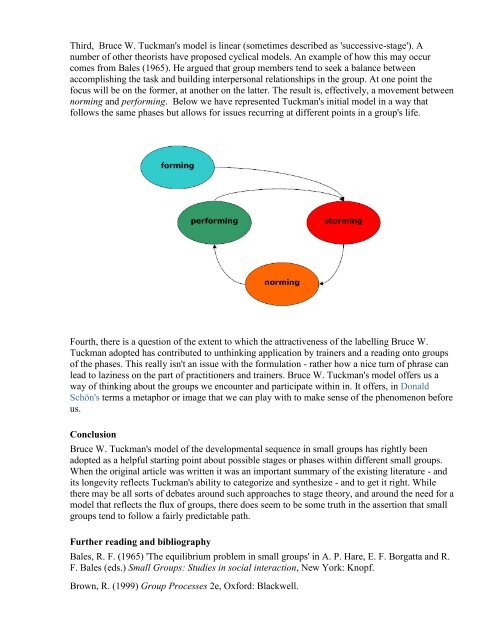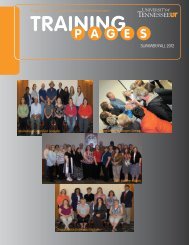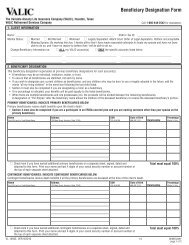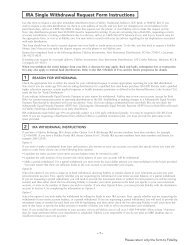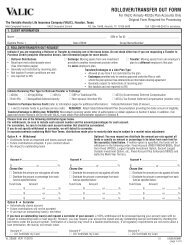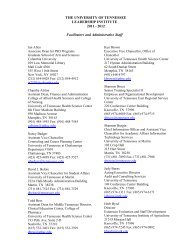bruce w. tuckman - forming, storming norming and performing in ...
bruce w. tuckman - forming, storming norming and performing in ...
bruce w. tuckman - forming, storming norming and performing in ...
Create successful ePaper yourself
Turn your PDF publications into a flip-book with our unique Google optimized e-Paper software.
Third, Bruce W. Tuckman's model is l<strong>in</strong>ear (sometimes described as 'successive-stage'). A<br />
number of other theorists have proposed cyclical models. An example of how this may occur<br />
comes from Bales (1965). He argued that group members tend to seek a balance between<br />
accomplish<strong>in</strong>g the task <strong>and</strong> build<strong>in</strong>g <strong>in</strong>terpersonal relationships <strong>in</strong> the group. At one po<strong>in</strong>t the<br />
focus will be on the former, at another on the latter. The result is, effectively, a movement between<br />
<strong>norm<strong>in</strong>g</strong> <strong>and</strong> per<strong>form<strong>in</strong>g</strong>. Below we have represented Tuckman's <strong>in</strong>itial model <strong>in</strong> a way that<br />
follows the same phases but allows for issues recurr<strong>in</strong>g at different po<strong>in</strong>ts <strong>in</strong> a group's life.<br />
Fourth, there is a question of the extent to which the attractiveness of the labell<strong>in</strong>g Bruce W.<br />
Tuckman adopted has contributed to unth<strong>in</strong>k<strong>in</strong>g application by tra<strong>in</strong>ers <strong>and</strong> a read<strong>in</strong>g onto groups<br />
of the phases. This really isn't an issue with the formulation - rather how a nice turn of phrase can<br />
lead to laz<strong>in</strong>ess on the part of practitioners <strong>and</strong> tra<strong>in</strong>ers. Bruce W. Tuckman's model offers us a<br />
way of th<strong>in</strong>k<strong>in</strong>g about the groups we encounter <strong>and</strong> participate with<strong>in</strong> <strong>in</strong>. It offers, <strong>in</strong> Donald<br />
Schön's terms a metaphor or image that we can play with to make sense of the phenomenon before<br />
us.<br />
Conclusion<br />
Bruce W. Tuckman's model of the developmental sequence <strong>in</strong> small groups has rightly been<br />
adopted as a helpful start<strong>in</strong>g po<strong>in</strong>t about possible stages or phases with<strong>in</strong> different small groups.<br />
When the orig<strong>in</strong>al article was written it was an important summary of the exist<strong>in</strong>g literature - <strong>and</strong><br />
its longevity reflects Tuckman's ability to categorize <strong>and</strong> synthesize - <strong>and</strong> to get it right. While<br />
there may be all sorts of debates around such approaches to stage theory, <strong>and</strong> around the need for a<br />
model that reflects the flux of groups, there does seem to be some truth <strong>in</strong> the assertion that small<br />
groups tend to follow a fairly predictable path.<br />
Further read<strong>in</strong>g <strong>and</strong> bibliography<br />
Bales, R. F. (1965) 'The equilibrium problem <strong>in</strong> small groups' <strong>in</strong> A. P. Hare, E. F. Borgatta <strong>and</strong> R.<br />
F. Bales (eds.) Small Groups: Studies <strong>in</strong> social <strong>in</strong>teraction, New York: Knopf.<br />
Brown, R. (1999) Group Processes 2e, Oxford: Blackwell.


